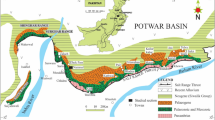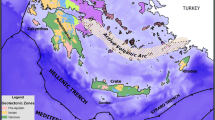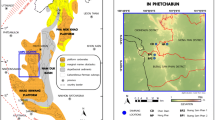Abstract
The Say’un–Masila rift, one of the most important basins of Yemen, contains unconventional resources of organic-rich rocks. In the present work, geochemical and palynofacies analyses were performed on the organic-rich source rock (argillaceous limestone) of the late Jurassic–early Cretaceous Naifa Formation in the Say’un–Masila Rift Basin to investigate its hydrocarbon generation potential. The geochemical analysis of the organic matter reveals that the argillaceous limestone unit has total organic carbon contents of 0.5–2.6%, which indicate fair to good hydrocarbon source potential. The organic matter in the analyzed samples is dominated by Type II/III and Type III kerogens, with minor Type II kerogen, referring to both oil- and gas-prone source rocks. The dominant kerogen Types II/III and Type III are indicated further from quantitative results based on an open pyrolysis–gas chromatography analysis. Biological markers and palynofacies analysis suggest that the kerogen was formed through a combination of mixed marine and high land plant organic matter and was preserved under sub-oxic sedimentary conditions. The different geochemical and optical maturity parameters indicate that the analyzed argillaceous limestone of the Naifa Formation is thermally mature, equivalent to early mature of oil-generation window. This implies that the burial depth of the analyzed samples is not deep enough; therefore, only the deeper parts of the Naifa source rocks at the basin have reached a satisfactory maturity level to be considered as potentially effective petroleum source rock. The biomarker source and depositional environment indicators presented and discussed in this study are useful for future exploration in the Say’un–Masila Basin for oil-to-oil and oil-to-source geochemical correlations and offer guidance for potential prospecting targets that may occur within the basin.


















Similar content being viewed by others
References
Abdullah, W. H. (1999). Oil generating potential of Tertiary coals and other organic-rich sediments of the Nyalau Formation, onshore Sarawak. Journal of Asian Earth Sciences,17, 255–267.
Abdullah, W. H., Togunwa, O. S., Makeen, Y. M., Hakimi, M. H., Mustapha, K. A., Baharuddin, M. H., et al. (2017). Hydrocarbon source potential of eocene–miocene sequence of Western Sabah, Malaysia. Marine and Petroleum Geology,83, 345–361.
Adegoke, A. K., Abdullah, W. H., & Hakimi, M. H. (2015). Geochemical and petrographic characterisation of organic matter from the Upper Cretaceous Fika shale succession in the Chad (Bornu) Basin, northeastern Nigeria: Origin and hydrocarbon generation potential. Marine and Petroleum Geology,61, 95–110.
Adegoke, A. K., Abdullah, W. H., & Yandoka, B. M. S. (2017). Provenance and paleoenvironment of organic matter within the Fika sediments in Chad (Bornu) Basin, northeastern Nigeria: An integrated organic geochemical and palynofacies approach. International Journal of Coal Geology,173(C), 94–109.
Al Areeq, N. A., & Al-Auge, A. S. (2014). Well log analysis and hydrocarbon potential of the Sa’ar–Nayfa reservoir, Hiswah Oilfield, eastern Yemen. Arabian Journal Geosciences. https://doi.org/10.1007/s12517-013-1003-5.
Al Areeq, N. A., & Maky, A. F. (2015). Organic geochemical characteristics of crude oils and oil-source rock correlation in the Sunah oilfield, Masila Region, Eastern Yemen. Marine and Petroleum Geology,63, 17–27.
Al Areeq, N. M., Soliman, M. A., Essa, M. A., & Al-Azazi, N. A. (2015). Diagenesis and reservoir quality analysis in the Lower Cretaceous Qishn sandstones from Masila oilfields in the Sayun–Masila Basin, eastern Yemen. Geological Journal.
Al-Areeq, N. M., Abu El Ata, A. S., Maky, A. F., & Omran, A. A. (2011). Hydrocarbon Potentialities of some upper jurassic rock units in Masila Block, Sayun-Masila basin, Yemen. National Research Center, Cairo. Journal of Applied Geophysics,10, 147–168.
Alias, F. L., Abdullah, W. H., Hakimi, M. H., Azhar, M. H., & Kugler, R. L. (2012). Organic geochemical characteristics and depositional environment of the Tertiary Tanjong Formation coals in the Pinangah area, onshore Sabah, Malaysia. International Journal of Coal Geology,104, 9–21.
Al-Wosabi, M. A., & Al-Mashaikie, S. Z. (2006). Investigation of facies types and associations of Kuhlan Red Bed Formation in NW Yemen: A new hypothesis for origin and depositional environment. SQU Journal for Science,11, 11–38.
Ardakania, O. M., Saneia, H., Ghanizadeh, A., McMechan, M., Ferric, F., & Clarkson, C. (2017). Hydrocarbon potential and reservoir characteristics of lower Cretaceous Garbutt Formation, Liard Basin Canada. Fuel,209, 274–289.
Batten, D. J., & Stead, D. T. (2005). Palynofacies analysis and its stratigraphic application. In E. A. M. Koutsoukos (Ed.), Applied stratigraphy (pp. 203–226). Amsterdam: Springer.
Bawazer, W., Lashin, A., & Kinawy, M. M. (2018). Characterization of a fractured basement reservoir using high-resolution 3D seismic and logging datasets: A case study of the Sab’atayn Basin, Yemen. PLoS ONE,13(10), e0206079.
Beydoun, Z. R. (1964). The stratigraphy and structure of the eastern Aden Protectorate. In Overseas geological and mineral resources (Bull. Supp. 5, pp. 1–107). London: HMSO.
Beydoun, Z. R., Al-Saruri, M., El-Nakhal, H., Al-Ganad, I. N., Baraba, R. S., Nani, A. S. O., et al. (1998). International lexicon of stratigraphy, V. III, Republic of Yemen, Second Ed. International Union of Geological Sciences and Ministry of Oil and Mineral Resources, Republic of Yemen, Publication 34, 245 p.
Chandra, K., Mishra, C. S., Samanta, U., Gupta, A., & Mehrotra, K. L. (1994). Correlation of different maturity parameters in the Ahmedabad–Mehsana Block of the Cambay Basin. Organic Geochemistry,21, 313–321.
Colombo, J. C., Pelletier, E., Brochu, C., Khalil, M., & Catoggio, J. A. (1989). Determination of hydrocarbon sources using n-alkane and polyaromatic hydrocarbon distribution indexes. Case study: Rio de La Plata estuary, Argentina. Environmental Science & Technology,23, 888–894.
Csato, I., Habib, A., Kiss, K., Kocz, I., Kovacs, V., Lorincz, K., et al. (2001). Play concepts of oil exploration in Yemen. Oil Gas Journal,99(23), 68–74.
Dembicki, H. J. (2009). Three common source rock evaluation errors made by geologists during prospect or play appraisals. APPG,93(3), 341–356.
Dembicki, H., Jr., Horsfield, H. B., & Ho, T. T. Y. (1983). Source rock evaluation by pyrolysis-gas chromatography. AAPG,67, 1094–1103.
Didyk, B. M., Simoneit, B. R. T., Brassell, S. C., & Eglinton, G. (1978). Organic geochemical indicators of palaeoenvironmental conditions of sedimentation. Nature,272, 216–222.
Durand, B., & Monin, J. C. (1980). Elemental analysis of kerogens (C, H, O, N, S, Fe). In B. Durand (Ed.), kerogen (pp. 113–142). Paris: Editions Technip.
Escobar, M., M’arquez, G., Inciarte, S., Rojas, J., Esteves, I., & Malandrino, G. (2011). The organic geochemistry of oil seeps from the Sierra de Perij’a eastern foothills, Lake Maracaibo Basin, Venezuela. Organic Geochemistry,42, 727–738.
Espitalié, J. (1985). Use of Tmax as a maturation index for different types of organic matter-comparison with vitrinite reflectance. In J. Burrus (Ed.), Thermal modeling in sedimentary basins (pp. 475–496). Paris: Editions Technip.
Espitalié, J. L., Laporte, M., Madec, F., Marquis, P., & Leplat, J. P. (1977). Methoderapide de caracterisation des roches meres, de leur potential petrolier et de leurdegre d’evolution Rev. Institute French of Petroleum,32, 23–42.
Farhaduzzaman, M., Abdullah, W. H., & Islam, M. A. (2012). Depositional environment and hydrocarbon source potential of the Permian Gondwana coals from the Barapukuria Basin, Northwest Bangladesh. International Journal of Coal Geology,90(91), 162–179.
Hakimi, M. H., Abdullah, W. H., Alias, F. L., Azhar, M. H., & Makeen, Y. M. (2013). Organic petrographic characteristics of Tertiary (Oligocene–Miocene) coals from eastern Malaysia: Rank and evidence for petroleum generation. Internal Journal of Coal Geology,20, 71–81.
Hakimi, M. H., Abdullah, W. H., & Shalaby, M. R. (2010a). Source rock characterization and oil generating potential of the Jurassic Madbi Formation, onshore East Shabowah oilfields, Republic of Yemen. Organic Geochemistry,41, 513–521.
Hakimi, M. H., Abdullah, W. H., & Shalaby, M. R. (2010b). Organic geochemistry, burial history and hydrocarbon generation modeling of the Upper Jurassic Madbi Formation, Masila Basin, Yemen. Journal of Petroleum Geology,33, 299–318.
Hakimi, M. H., Abdullah, W. H., & Shalaby, M. R. (2011). Organic geochemical characteristics and depositional environments of the Jurassic shales in the Masila Basin of Eastern Yemen. GeoArabia,16, 47–64.
Hakimi, M. H., Abdullah, W. H., & Shalaby, M. R. (2012a). Geochemical and petrographic characterization of organic matter in the Upper Jurassic Madbi shale succession (Masila Basin, Yemen): Origin, type and preservation. Organic Geochemistry,49, 18–29.
Hakimi, M. H., Al-Qadasi, B. A., Al-Sorore, O.T., Al-Sharrabi, Y., & Al-Samet, N. G., (2016). Petrophysical properties of Cretaceous clastic rocks (Qishn formation) in the Sharyoof oilfield, onshore Masila Basin, Yemen. Egyptian Journal of Petroleum (In press).
Hakimi, M. H., Shalaby, M. R., & Abdullah, W. H. (2012b). Diagenetic characteristics and reservoir quality of the Lower Cretaceous Biyadh sandstones at Kharir oilfield in the western central Masila Basin, Yemen. Journal Asian Earth Sciences,51, 109–120.
Harry, D. J. (2008). Three common source rock evaluation errors made by geologists during prospect or play appraisals. AAPG,93, 4341–4356.
Horsfield, B. (1989). Practical criteria for classifying kerogens: Some observations from pyrolysis–gas chromatography. Geochimica et Cosmochimica Acta,53, 891–901.
Horsfield, B. (1997). The bulk composition of first-formed petroleum in source rocks. In D. H. Welte, B. Horsfield, & D. R. Backer (Eds.), Petroleum and basin evolution; insights from petroleum geochemistry, geology and basin modeling. Berlin: Springer.
Horsfield, B., & Dueppenbecker, S. (1991). The decomposition of Posidonia Shale and Green River Shale kerogens using micro-scale sealed vessel (MSSV) pyrolysis. Journal of Analytical and Applied Pyrolysis,20, 107–123.
Huang, W. Y., & Meinschein, W. G. (1979). Sterols as ecological indicators. Geochimica et Cosmochimica Acta,43, 739–745.
Huang, W. B., Salad Hersi, O., Lu, S. F., & Deng, S. W. (2017). Quantitative modelling of hydrocarbon expulsion and quality grading of tight oil lacustrine source rocks: Case study of Qingshankou 1 member, central depression, Southern Songliao Basin, China. Marine and Petroleum Geology,84, 34–48.
Hunt, J. M. (1996). Petroleum geochemistry and geology. New York: W.H. Freeman and Company.
Katz, B.J. (2005). Controlling factors on source rock development—a review of productivity, preservation and sedimentation rate. In N. B. Harris (Ed.), The depositional of organic-carbon-rich rocks: models, mechanisms and consequences (Vol. 82, pp. 7–16). SEPM Special Publication.
Khamis, M., Marta, E. B., Al Natifi, A., Fattah, K. A., & Lashin, A. (2017). Simulation of the multi zones clastic reservoir: A case study of Upper Qishn clastic member, Masila Basin-Yemen. Journal African Earth Sciences,130, 252–268.
King, W. A., Mills, B. R., Gardiner, S., & Abdillah, A. A. (2003). The Masila fields, Republic of Yemen. In M. T. Halbouty (Ed.), Giant oil and gas fields of the decade 1990–1999. AAPG memories (Vol. 78, pp. 275–295).
Larter, S. R. (1984). Application of analytical pyrolysis technique to kerogen characterization and fossil fuel exploitation. In K. Voorhees (Ed.), Analytical pyrolysis (pp. 212–275). London: Butterworth.
Lashin, A., Marta, E. B., & Khamis, M. (2016). Characterization of the Qishn sandstone reservoir, Masila Basin-Yemen, using an integrated petrophysical and seismic structural approach. Journal African Earth Sciences,115, 121–142.
Mackenzie, A. S., Patience, R. L., Maxwell, J. R., Vandenbroucke, M., & Durand, B. (1980). Molecular parameters of maturation in the Toarcian shales, Paris Basin, France. Changes in the configuration of acyclic isoprenoids alkanes, steranes and triterpanes. Geochimica et Cosmochimica Acta,44, 1709–1721.
Makeen, Y. M., Abdullah, W. H., & Hakimi, M. H. (2015). Biological markers and organic petrology study of organic matter in the Lower Cretaceous Abu Gabra sediments (Muglad Basin, Sudan): Origin, type and palaeoenvironmental conditions. Arabian Journal Geosciences,8, 489–506.
Manning, D. A. C. (1991). Organic geochemistry: Advances and applications in the natural environment. Manchester, UK: Manchester University Press.
Mills, S. J. (1992). Oil discoveries in the Hadramaut: How Canadian oxy scored in Yemen. Oil Gas Journal,49, 52.
Mohialdeen, I. M. J., & Hakimi, M. H. (2016). Geochemical characterisation of Tithonian–Berriasian Chia Gara organic-rich rocks in northern Iraq with an emphasis on organic matter enrichment and the relationship to the bioproductivity and anoxia conditions. Journal of Asian Earth Sciences,116, 181–197.
Moldowan, J. M., Sundararaman, P., & Schoell, M. (1986). Sensitivity of biomarker properties to depositional environment and/or source input in the Lower Toarcian of S.W, Germany. Organic Geochemistry,10, 915–926.
Nøhr-Hansen, H. (1989). Visual and chemical kerogen analyses of the Lower Kimmeridgain Clay, Westbury, England. In D. J. Batten & M. C. Keen (Eds.), Northwest European micropalaeontology and palynology (pp. 118–132). Chichester: Ellis Horwood Limited.
Peters, K. E., & Cassa, M. R. (1994). Applied source rock geochemistry. In L. B. Magoon & W. G. Dow (Eds.), The petroleum system-from source to trap. AAPG memories (Vol. 60, pp. 93–120).
Peters, K. E., & Moldowan, J. M. (1993). The biomarker tuide: Interpreting molecular fossils, petroleum and ancient sediments (p. 363). New Jersey: Prentice Hall.
Peters, K. E., Walters, C. C., & Moldowan, J. M. (2005). The biomarker guide (p. 1155). UK: Cambridge University Press.
Ramanampisoa, L., Radke, M., Schaeffer, G., Littke, R., Rullkötter, J., & Horsfield, B. (1990). Organic-geochemical characterisation of sediments from the Sakoa coalfield, Madagascar. Organic Geochemistry,16, 235–246.
Redfern, P., & Jones, J. A. (1995). The interior basins of Yemen-analysis of basin structure and stratigraphy in a regional plate tectonic context. Basin Research,7, 337–356.
Robinson, K. J. (1987). An overview of source rocks and oils in Indonesia. In Proceedings of the Indonesian Petroleum Association, 16th annual convention, V 1. Indonesian Petroleum Association, Jakarta (pp. 97–122).
Sarki Yandoka, B. M., Abubakar, M. B., Abdullah, W. H., Hakimi, M. H., & Adegoke, A. K. (2015a). Geochemistry of the Cretaceous coals from Lamja Formation, Yola Sub-basin, Northern Benue Trough, NE Nigeria: Implications for paleoenvironment, paleoclimate and tectonic setting. Journal of African Earth Sciences,104, 56–70.
Sarki Yandoka, B. M., Abubakar, M. B., Abdullah, W. H., Hakimi, M. H., & Adegoke, A. K. (2015b). Geochemical characterisation of Early Cretaceous lacustrine sediments of Bima Formation, Yola Sub-basin, Northern Benue Trough, NE Nigeria: Organic matter input, preservation, paleoenvironment and paleoclimatic conditions. Marine and Petroleum Geology,61, 82–94.
Seifert, W. K., & Moldowan, J. M. (1978). Applications of steranes, terpanes and monoaromatics to the maturation, migration and source of crude oils. Geochimica et Cosmochimica Acta,42, 77–95.
Seifert, W. K., & Moldowan, J. M. (1981). Palaeoreconstruction by biological markers. Geochimica et Cosmochimica Acta,45, 783–794.
Seifert, W. K., & Moldowan, J. M. (1986). Use of biological markers in petroleum exploration. In R. B. Johns (Ed.), Methods in geochemistry and geophysics book series (Vol. 24, pp. 261–90). Amsterdam
SPT. (1994). The petroleum geology of the sedimentary basins of the republic of Yemen, V. 1e7 (unpublished report).
Staplin, F. L. (1982). Determination of thermal alteration index from color of exinite (pollen, spores). In F.L. Staplin (Ed.), How to assess maturation and paleotemperatures. SEPM short course (Vol. 7, pp. 7–11).
Sweeney, J. J., & Burnham, A. K. (1990). Evaluation of a simple model of vitrinite reflectance based on chemical kinetics. AAPG,74, 1559–1570.
Teichmuller, M. (1958). Metamorphism du carbon etpropection du petrole (pp. 1–15). Special Issue: Review of Industrial Minerals.
Tissot, B. T., & Welte, D. H. (1984). Petroleum formation and occurrences (2nd ed.). Berlin: Springer.
Togunwa, O. S., Abdullah, W. H., Hakimi, M. H., & Barbeitoc, P. J. (2015). Organic geochemical and petrographic characteristics of Neogene organic-rich sediments from the onshore West Baram Delta Province, Sarawak Basin: Implications for source rocks and hydrocarbon generation potential. Marine and Petroleum Geology,63, 115–126.
Tyson, R. V. (1995). Sedimentary organic matter: Organic facies and palynofacies (p. 615). London: Chapman and Hall.
Waples, D. W, & Machihara T. (1991). Biomarkers for Geologists: A practical guide to the application of steranes and triterpanes in petroleum geology. In AAPG methods in exploration series, 9, Tulsa, Oklahoma.
Acknowledgments
The Petroleum Exploration and Production Authority (PEPA) and the Total Oil Exploration and Production Company, Republic of Yemen, are acknowledged for providing the data used in the current study. The authors extend their sincere appreciation to the Researchers Supporting Project number (RSP-2019/92), King Saud University, Riyadh, Saudi Arabia. Special thanks go to the Department of Geology, University of Malaya, Malaysia, for providing the use of organic geochemical and petrology facilities to complete this research. The constructive comments by the editor and the anonymous reviewers that improved the original article are gratefully acknowledged.
Author information
Authors and Affiliations
Corresponding author
Appendix
Appendix
See Table 5.
Rights and permissions
About this article
Cite this article
Hakimi, M.H., Abdullah, W.H., Lashin, A.A. et al. Hydrocarbon Generation Potential of the Organic-Rich Naifa Formation, Say’un–Masila Rift Basin, Yemen: Insights from Geochemical and Palynofacies Analyses. Nat Resour Res 29, 2687–2715 (2020). https://doi.org/10.1007/s11053-019-09595-1
Received:
Accepted:
Published:
Issue Date:
DOI: https://doi.org/10.1007/s11053-019-09595-1




